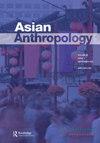The moving city: scenes from the Delhi Metro and the social life of infrastructure
Q2 Social Sciences
引用次数: 1
Abstract
life of lab workers interlaced with four studies of the “public life of blood” based on readings of newspaper reporting on national blood donation programmes, laboratory life, elections, and more. For Carsten this interlacing of media analyses with laboratory ethnography allows her “to calibrate the material in the ethnographic chapters [in order to] complement and broaden themes in the ethnography” (p. 27). It is this juxtaposition which allows Carsten to innovatively show how “medical lab technologists, lab technicians, receptionists, lab managers, and nurses (as well as donors and patients) are directly and indirectly informed by publicity about blood donation, health scares, stories about organ donation, or hospitals that appear in the media, by the ways these are picked up by members of the public who are also potential donors” (p. 27). As an example, Carsten shows how news coverage of blood drives allows blood donation to function as a “symbolic vector” linking matters of health, the family, selfless giving, and a “spirit of Malaysia.” She then goes on to ethnographically trace the bureaucratic forms that are filled out and the various screening tests that potential donors must undergo in blood banks, showing how “histories of relatedness and moral, medical, and other categories penetrate each other and are inseparably entangled within acts of blood donation [such that] donors can equally be construed as citizens of an ethnically plural nation” (pp. 71, 73). In recent decades, we have seen ethnographers develop novel analytical and methodological strategies that allow for ways of locating intimate experiences, such as working in a laboratory carrying out blood work in Penang, within processes that operate at another scale, such as nation-building and modernization that take shape through policy processes, media coverage, and governmental programmes. Such approaches have been described by Escobar as “institutional ethnography,” by Marcus as “multi-sited ethnography,” by Feldman as “non-local ethnography,” and by Wahlberg as “assemblage ethnography,” among scholars’ recently coined terms. Carsten has innovatively woven different scales together ethnographically, and in doing so has shown us how “a close examination of seemingly routine and understated practices, and the lives of those who enact them, has revealed how the supposedly separate domains of kinship, politics, economics, science, and religion – the hallmark of ‘modernity’ – in fact bleed into each other” (p. 208). In this way Blood Work makes a brilliant and original contribution to a growing set of ethnographies that have explored the work that goes on in technoscience laboratories, insisting that we “rehumanize” our study of such sites as places where career hopes, family dreams and everyday life circumstances are constantly reshaped.移动的城市:德里地铁的场景和基础设施的社会生活
实验室工作人员的生活与四项关于“血液公共生活”的研究交织在一起,这些研究基于对国家献血计划、实验室生活、选举等方面的报纸报道的阅读。对于卡斯滕来说,这种媒介分析与实验室民族志的交织使她能够“校准民族志章节中的材料,[以便]补充和扩大民族志的主题”(第27页)。正是这种并列使得卡斯滕创新地展示了“医学实验室技术人员、实验室技术人员、接待员、实验室管理人员和护士(以及献血者和患者)是如何直接或间接地从媒体上出现的献血宣传、健康恐慌、器官捐赠故事或医院中获得信息的,通过这些方式,这些信息被同样是潜在献血者的公众成员所接受”(第27页)。Carsten举例说明,有关献血活动的新闻报导,让献血成为连结健康、家庭、无私奉献与“马来西亚精神”的“象征性媒介”。然后,她继续从人种学的角度追溯了人们填写的官僚表格,以及潜在献血者必须在血库中接受的各种筛选测试,显示了“血缘、道德、医疗和其他类别的历史如何相互渗透,并在献血行为中不可分割地纠缠在一起,[这样]献血者可以被平等地解释为一个多元种族国家的公民”(第71页,第73页)。近几十年来,我们看到民族学家发展出新颖的分析和方法策略,允许在另一个规模的过程中定位亲密体验的方法,例如在槟城的实验室进行血液检测,例如通过政策过程、媒体报道和政府计划形成的国家建设和现代化。这些方法被Escobar描述为“制度人种学”,Marcus描述为“多地点人种学”,Feldman描述为“非地方人种学”,Wahlberg描述为“集合人种学”,这些都是学者们最近创造的术语。卡斯滕在民族志上创造性地将不同的尺度编织在一起,并通过这样做向我们展示了“对看似常规和低调的实践以及制定这些实践的人的生活的仔细检查,揭示了所谓的亲属关系,政治,经济,科学和宗教的独立领域- '现代性'的标志-实际上是如何相互渗透的”(第208页)。通过这种方式,《血液工作》为不断增长的民族志研究做出了杰出而原创的贡献,这些研究探索了在技术科学实验室中进行的工作,坚持认为我们要“重新人性化”我们对这些地点的研究,因为这些地方的职业希望、家庭梦想和日常生活环境不断被重塑。
本文章由计算机程序翻译,如有差异,请以英文原文为准。
求助全文
约1分钟内获得全文
求助全文
来源期刊

Asian anthropology
Social Sciences-Anthropology
CiteScore
1.60
自引率
0.00%
发文量
25
期刊介绍:
Asian Anthropology seeks to bring interesting and exciting new anthropological research on Asia to a global audience. Until recently, anthropologists writing on a range of Asian topics in English but seeking a global audience have had to depend largely on Western-based journals to publish their works. Given the increasing number of indigenous anthropologists and anthropologists based in Asia, as well as the increasing interest in Asia among anthropologists everywhere, it is important to have an anthropology journal that is refereed on a global basis but that is editorially Asian-based. Asian Anthropology is editorially based in Hong Kong, Taiwan, and Japan, but welcomes contributions from anthropologists and anthropology-related scholars throughout the world with an interest in Asia, especially East Asia as well as Southeast and South Asia. While the language of the journal is English, we also seek original works translated into English, which will facilitate greater participation and scholarly exchange. The journal will provide a forum for anthropologists working on Asia, in the broadest sense of the term "Asia". We seek your general support through submissions, subscriptions, and comments.
 求助内容:
求助内容: 应助结果提醒方式:
应助结果提醒方式:


